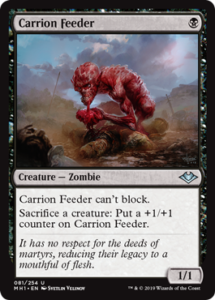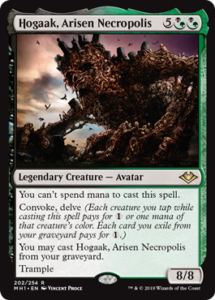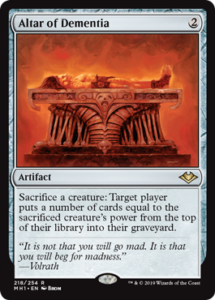The zombie craze isn’t just for TV anymore: Modern was overrun by the walking dead with the release of Modern Horizons. With the next banned list update scheduled for July 8, it seemed inevitable that the hordes would descend on the unfortunate tournaments in between. As someone who played Bridgevine before it was cool (i.e. before it was good), I couldn’t pass up the chance to be part of history.
I was rewarded with a win for my team at the SCG Open in Pittsburgh:
Hogaak Bridgevine, by Dom Harvey
| Creatures (26) 4 Stitcher’s Supplier 4 Insolent Neonate 4 Carrion Feeder 3 Gravecrawler 3 Bloodghast 4 Vengevine 4 Hogaak, Arisen Necropolis Spells (15) 4 Altar of Dementia 4 Faithless Looting 4 Bridge from Below 1 Lightning Axe 2 Leyline of the Void | Lands (19) 3 Bloodstained Mire 3 Polluted Delta 1 Marsh Flats 3 Blackcleave Cliffs 3 Blood Crypt 3 Verdant Catacombs 2 Godless Shrine 1 Swamp Sideboard (15) 2 Leyline of the Void 3 Cryptbreaker 2 Thoughtseize 4 Wispmare 1 Plague Engineer 2 Fatal Push 1 Wear // Tear |
I expect this deck is enjoying its last few days in the sun. But its brief reign of terror has instructive lessons for the format and deckbuilding in general. Compare it to the Bridgevine prototypes from this time last year:
Bridgevine, by Jacob Nagro
| Creatures (35) 4 Stitcher’s Supplier 4 Goblin Bushwhacker 4 Insolent Neonate 4 Gravecrawler 4 Walking Ballista 3 Hangarback Walker 4 Bloodghast 4 Vengevine 4 Greater Gargadon Spells (8) 4 Faithless Looting 4 Bridge from Below | Lands (17) 2 Bloodstained Mire 2 Arid Mesa 2 Wooded Foothills 2 Scalding Tarn 4 Blackcleave Cliffs 4 Blood Crypt 1 Mountain Sideboard (15) 4 Leyline of the Void 3 Ingot Chewer 3 Lightning Axe 3 Thoughtseize 2 Bitterblossom |
For a brief moment, Bridgevine seemed poised to warp the format the way its descendant has. As a blisteringly fast aggro-combo deck that could also grind out games with Gravecrawler loops and Greater Gargadon or steal games out of nowhere with Goblin Bushwhacker, its best draws looked very impressive.
But as the spotlight shone on the deck, its flaws became clear. Beating Bridgevine meant facing down overwhelming board presence as early as the second turn—one that could go tall with Greater Gargadon and Vengevine, or wide with a bevy of cheap attackers. But if you could survive this first wave, you were likely to win as the deck had spent most of its resources and couldn’t develop its board much further.
This made matchups like Humans or Hardened Scales tricky. You needed a strong draw to outrace them before they could lock up the ground. In matchups where you could goldfish—against the likes of KCI or Storm—your average draws weren’t fast enough to win that race. Bridgevine also suffered from natural inconsistencies, relying on finding Vengevine or Bridge from Below, but lacking good ways to discard them. And then you need a motley crew of 1/1s and 2/1s to finish the job.
Modern Horizons helped Bridgevine more than any other deck, giving it the tools to fix all these problems.

Carrion Feeder by itself would have renewed interest in the deck. Greater Gargadon was excellent in longer games but clunky in shorter ones, failing to trigger Vengevine early and providing no immediate benefit when activated. Viscera Seer could reliably find specific cards but often too late to make a difference.
The boost in power is far more useful in a deck that wants to deal large chunks of damage early. As a Zombie, Carrion Feeder sets up Gravecrawler loops much more easily, not just for Vengevine, but for itself as you could pay B to put a counter on Feeder and balloon it to a ridiculous size. As the game continues Feeder enables great attacks where the threat of activation makes combat impossible for the opponent and forces awkward blocks.

Any stalled board quickly collapses under Hogaak. The 8/8 body outsizes everything in the format—including, crucially, a transformed Awoken Horror—and tramples over smaller creatures that are good at containing Vengevine or large Carrion Feeders.
Outside of Path to Exile, Hogaak is immune to Modern’s common removal and can come back for more if it does die somehow. Casting it for “free” allows more explosive Vengevine turns and, more broadly, gives you more “god draws” that make the opponent need their own to keep up.

To the untrained eye, Altar of Dementia is a strange but seemingly harmless card that marries the two greatest loves of many casual players: large creatures and mill. To the experienced player, Altar is a bizarre choice to reprint: either it does nothing or enables some degenerate combo.
Few cards could hope to solve the problem Altar does: giving the deck a way to win without going through the red zone. This new build can easily mill itself with Altar until it can start recasting Hogaak and sacrificing it to Altar with Bridge spawning Zombies that can recast the Hogaak, repeating until the opponent’s whole deck joins yours in the graveyard. Any draw with a turn two Altar and any other material has a good chance of winning the next turn. That shifs the deck’s “fundamental” turn to turn three, turning races like Tron or Infect in your favor.
With this many moving parts, most of the deck is locked in and there are only a few slots to play with. Bloodghast was highly underwhelming and the first “normal” card boarded out; working them out of the deck altogether would open up valuable space in the 75. It’s a sign of the times that many Hogaak lists played several Leyline of the Void maindeck and wish they had played more. The card is fine in this strategy anyway, protecting Bridge from Below and incidentally hosing some decks, but it is the ultimate superweapon for the mirror where games devolve into trying to draw your own Leyline, dodge or remove your opponent’s, or win the clown show that ensues when both players have one. If I played the deck again, I would strongly consider sideboarding Serum Powder as a way to tilt those odds in my favor.
Card choices are a sideshow as attention focuses on possible bans. It’s easy to look at this weekend’s results and laugh at the people who said the sky was falling. Hogaak didn’t dominate either Top 8 in Pittsburgh or GP Dallas and wasn’t even the most popular deck as Arclight Phoenix continued to rule the skies. With that in mind it seems Modern has adjusted and that, if anything, this weekend was more about Faithless Looting than anything unique to Hogaak.
Ban something anyway. What you see here is the deck’s performance—still a solid one by all metrics—in a format that is contorting itself beyond belief to hate out Hogaak. Every deck has six sideboard slots spoken for and several maindeck slots too. Any deck too fundamentally weak to Hogaak is forced out of the format.
Many games against Hogaak are a single-player affair thanks to ridiculous draws or nuclear hate. In my semifinals match against my new teammate Harlan Firer, I got to cast turn two Hogaak on the play through Tormod’s Crypt, and that didn’t feel unlikely or special. The deck is difficult to optimize and throws up interesting sequencing decisions, but too often these are irrelevant. If you care about play patterns or the long-term health of the format, it’s hard to mount a defense of Hogaak.
What should pay the price? It’s a bad look to ban cards (re)printed just months ago in a set meant to shake up Modern. Bridge from Below is a card only Future Sight could love that’s always up to some mischief when it gets the chance; nobody would shed many tears for it. But my view is that the time has come (or rather is here yet again) to take out Faithless Looting. While it is the cornerstone of many different graveyard strategies, in practice it limits the available graveyard strategies to those that best use Faithless Looting. If one of those becomes too good, it effectively drives out the others as graveyard hate has to intensify massively as a response. Dredge was already a problem by this standard, and Hogaak is the thickest exclamation point possible.
Regardless of what happens next Monday, I’m glad I could be a part of Modern’s increasingly chequered history and take home a trophy in one of the strangest formats I can remember.

